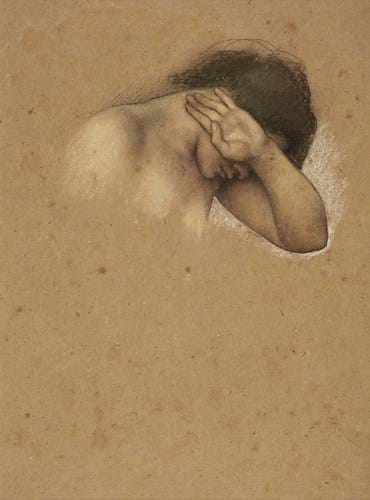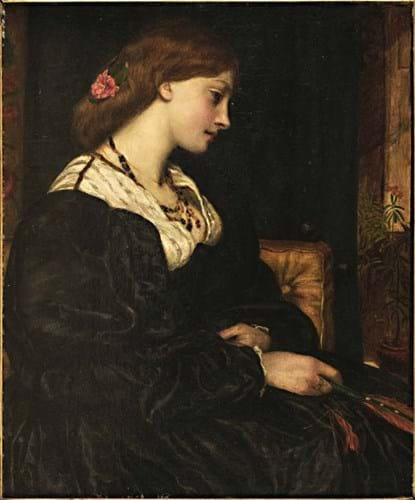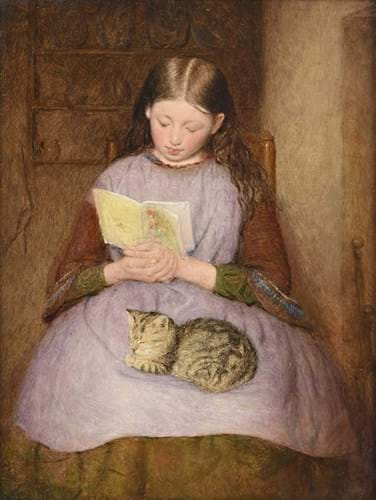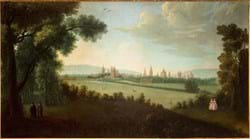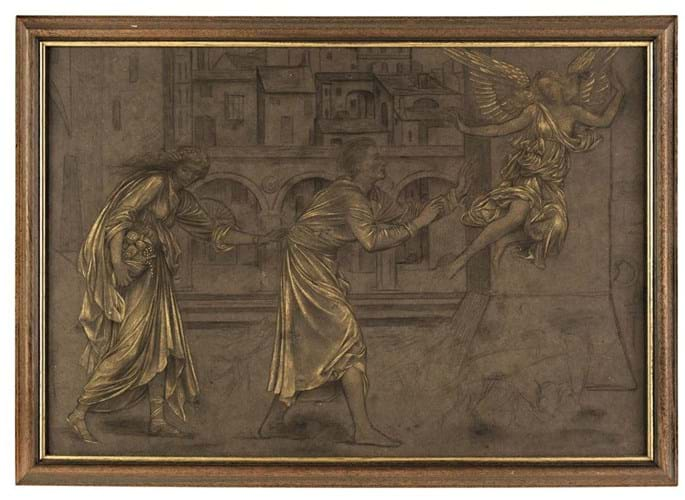
Blindness and Cupidity Chasing Joy from the City, a gold coloured pastel study from c.1897 by Evelyn De Morgan, £40,000 at Dominic Winter.
Back in November 2018, Gloucestershire saleroom Dominic Winter (20% buyer’s premium) offered what was believed to be the first gold pastel work by Evelyn De Morgan (1855-1919) to appear at auction.
Selling at £39,000, the remarkable study of two figures titled The Angel of Death set a record for a work on paper by the artist at the time.
At the firm’s latest picture sale on July 20, three more works by De Morgan appeared from the same vendor including another gold-coloured study that duly sparked similar levels of interest.
The group was consigned by a descendant of Maxwell David Eugene Clayton-Stamm, a collector of Pre-Raphaelite art in the 1950s-70s and co-author of a book on Evelyn’s husband, ceramic designer William De Morgan.
Allegorical oil
The drawing here was a study for Evelyn De Morgan’s large-scale allegorical oil Blindness and Cupidity Chasing Joy from the City, painted in 1897, and now owned by The De Morgan Foundation.
Director and picture specialist at the South Cerney auction house Nathan Winter told ATG that the quality and overall appeal of the work was beyond most preparatory studies. He said it was in effect a trial run where she was rehearsing the full worked-up painted version.
Indeed, it seems that the artist herself considered these gold pictures works of art in their own right and apparently sold them as such.
Describing it as having “tremendous power”, Winter said the dexterity with which she handled the medium with the way the gold brushstrokes highlighted the details to the garments and figures gave impetus to buyers.
The rarity of the work boosted this further. Only a small number of works executed in gold coloured pastel and black chalk on dark wove paper like this are known in De Morgan’s oeuvre. One study titled Victoria Dolorosa is in Leighton House Museum with most of the others held by the De Morgan Foundation.
The Angel of Death, which seemingly remains the only other example to emerge at auction, is still privately owned (it sold to a London dealer at the auction in 2018 who was bidding on behalf of a private client).
Not many artists adopted this medium, although one who did was De Morgan’s long-time friend and colleague Edward Burne-Jones who probably introduced her to the form.
De Morgan bought dry ‘cakes’ of gold pigment which she ground to make her own paint and pastels, using them to infuse light and warmth into these meticulous and detailed compositional studies.
The De Morgan Foundation states: “These curious artworks are unlike works by any other artists of the period”, adding that they “sparkle with a rare luminosity”.
With 14 of them currently on view at a Leighton House exhibition in London (which runs until October), they have received some extra attention of late which, along with the greater interest female artists are now generating in general, added to the commercial appeal of the current picture.
The 15¾ x 23¼in (40 x 59 cm) work on paper depicted the robed female figure of Cupidity carrying a hoard of precious objects, reaching out towards the male figure of Blindness. The two figures drive out the angel of Joy from the city towards an iron gate.
The subject, as ever with De Morgan, was a morality tale: in this case about the spiritual desolation caused by materialism and greed.
The fact that the lower right of the work was not fully completed but was instead left in sketch form may have detracted from it a little to some minds. However, by showing the working processes of the artist, this may have in fact lent it further interest to more academically minded collectors.
Winter said the condition was “good for such a delicate work but not quite perfect”, adding that it was not as exceptionally preserved as The Angel of Death sold in 2018. A few defects included some small patches of surface abrasion and some fox spots to the lower edge.
Offered with a keen pitch of £5000-8000, the estimate always looked likely to be exceeded significantly and indeed, on the day, no fewer than eight phone lines were booked, half from private collectors and the others all London dealers. It was eventually knocked down at £40,000 to one of the latter.
The performance of the work indicated the interest that remains in exceptional pieces of Victorian art. Winter told ATG: “If you’re able to offer good examples of works which have limited availability then you’re on to a good thing.”
Captives audience
Another preparatory study of a female head by De Morgan also sparked strong competition, selling to the same buyer. The 5¼ x 6¾in (13 x 17cm) coloured chalk and pastel drawing was a study for a figure in The Captives, another painting held by the De Morgan Foundation.
The finished picture shows five classically draped female figures in a cave among writhing dragons and this study shows the figure to the lower left covering her eyes in fear.
The Dominic Winter catalogue described it “a typical example of the artist’s careful preparatory works, showing an accurate delineation of limbs and attitude, and exquisitely drawn features”. Again, the estimate of £1000-1500 looked highly attainable and it made £21,000.
The third work by the artist from the Clayton-Stamm collection at the current sale indicated some selectivity remains in the market even for such a sought-after name as De Morgan.
Another preparatory study of a female head, it was not certain which finished picture it may relate to although it was thought it could be for a late large painting titled The Passing of the Soul at Death. Guided at £2000-3000, it sold at £3800.
Prinsep portrait
The same source yielded a further three works to the sale, two of which sold here. The pick of the non-De Morgan lots was a Valentine Cameron Prinsep (1838-1904) portrait that overshot a £5000-8000 estimate and sold at £35,000 to a private buyer bidding online.
The 16¼ x 14½in (41 x 37cm) oil on canvas from c.1860 depicted the artist’s sister Alice. She lived with her husband at Little Holland House in Kensington, where they hosted many of the prominent artistic and literary figures of the day, including Burne-Jones, Leighton, Millais, Rossetti, Dickens, Tennyson and Thackeray.
This portrait was probably painted at their house not long before Prinsep first started exhibiting at the Royal Academy.
The depiction of a red-haired and wistful female figure made it something of an archetypal Pre- Raphaelite-style image. It was described by the auction house as “beautifully painted” and in good condition.
It drew four bidders including a dealer who ended up as the underbidder. The price was the highest for the artist at auction since the much larger painting Sisters made a record £100,000 at Christie’s in June 2021.
The other work from the same source was a portrait of a man attributed to Jacob Willemsz. Delff the Younger (1619-61) which took a top-estimate £12,000. The picture will be featured together with other Old Masters from the sale in a future issue of ATG.
A good read
Another archetypal Victorian portrait that drew a notable contest at a separate sale just five days earlier was a painting of a young girl reading with a cat nestled in her lap.
Reading Time, an 8½in x 6¾in (22 x 17cm) oil on panel, appeared at Tennants (24% buyer’s premium) in Leyburn on July 15. It was attributed to Edward Thompson Davis (1833-67), a genre painter who regularly produced images of country life, often with children or families.
The work was a small example but arguably less sentimental than much of the Worcester-born artist’s output. In decent and ‘presentable’ condition according to the catalogue, the lot attracted plenty of interest against a there-to-be-sold estimate of just £500-800. It sold at £12,000 to a UK private buyer bidding via thesaleroom.com.
The price stands in the top 10 auction prices for the artist according to Artprice.com.


